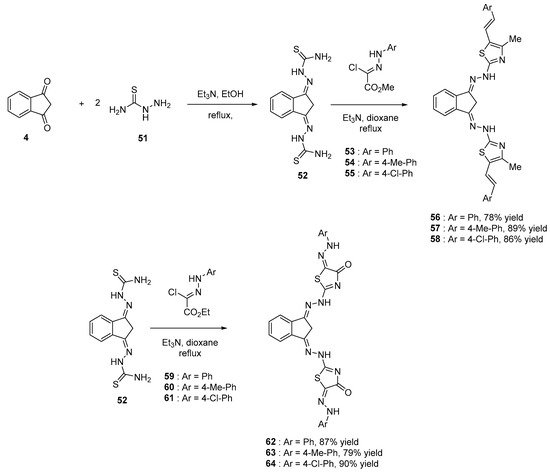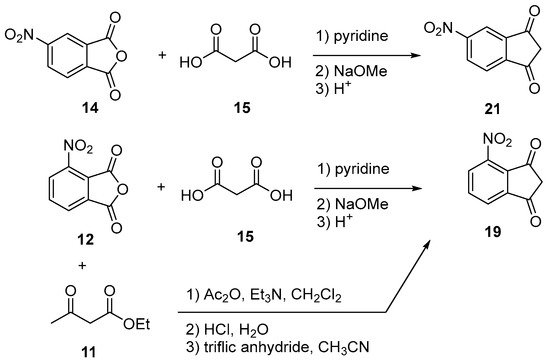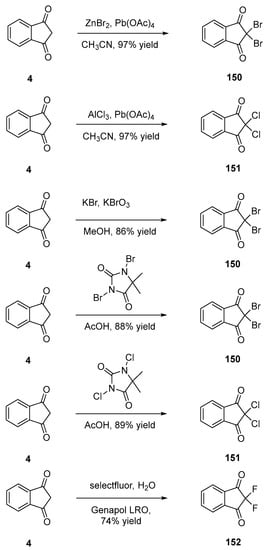Indane-1,3-dione is a versatile building block used in numerous applications ranging from biosensing, bioactivity, bioimaging to electronics or photopolymerization. Indan this re-1-3-dione is among oneview, an overview of the most privilegeddifferent chemical reactions enabling access to this scaffolds in chemistry, as the but also to the most common derivatives of this structure can findindane-1,3-dione are presented. Parallel to this, the different applications in various research fields ranging from medicinal chemistry, organic electronics, photopolymerization, to optical sensing and non-linear optical (NLO) applicationswhich indane-1,3-dione-based structures have been used are also presented, evidencing the versatility of this structure.
- indanedione
- chemical modification
- domino reaction
- MCR
- spiro compounds
1. Introduction
2. Chemical Modification of the Indane-1,3-Dione Core
2.1. Synthesis of Indane-1,3-Dione
Indane-1,3-dione can be synthesized following different synthetic procedures. Furthermore, the most straightforward one consists in the nucleophilic addition of alkyl acetate 2 on dialkyl phthalate 1 under basic conditions, enabling to produce the intermediate 2-(ethoxycarbonyl)-1,3-dioxo-2,3-dihydro-1H-inden-2-ide anion 3. Then, by heating under acidic conditions, this intermediate can be hydrolyzed and decarboxylated in situ, producing indane-1,3-dione 4 in ca. 50% yield for the two steps [13][14][13,14]. However, several procedures were also reported to access 4 by oxidation of indane 5, using various oxidizing systems such as N-hydroxyphthalimide (NHPI) and tert-butyl nitrite (t-BuONO) [15], H2O2 with a Mn catalyst [16], pyridinium dichromate (PCC) in the presence of Adogen 464 and sodium percarbonate (Na2CO3·1.5 H2O2) [17]. Furthermore, in these different cases, reaction yields remained often limited (17 and 18% yields) while requiring expensive reagents so that the first procedure remains undoubtedly the most popular one to obtain indane-1,3-dione 4 in acceptable yield (see Scheme 1). Recently, a two-step procedure was developed, starting from 2-ethynylbenzaldehyde 6 [18]. By means of a Cu-catalyzed intramolecular annulation reaction, 3-hydroxy-2,3-dihydro-1H-inden-1-one 7 was prepared in 87% yield and a subsequent oxidation of 7 with Jones’ reagent enabled to obtain 4 in 95% yield. As alternative, o-iodoxybenzoic acid (IBX) can also be used as an oxidant, providing 4 in similar yield (92%) [19]. Several strategies were also developed to convert phthalic anhydride 8 into 4 using diethyl malonate 9 and montmorillonite KSF clay [20] or ethyl acetoacetate 11 in the presence of acetic anhydride and triethylamine [21]. In the case of substituted indane-1,3-diones, two distinct routes were developed depending on the substituents attached on the phthalic anhydrides. Thus, in the case of electron-withdrawing groups such as nitro and chlorine (12–14), the condensation of malonic acid in pyridine proved to be a straightforward route to access 19–21 [22]. Conversely, in the case of electron-donating groups such as alkyl substituents (22, 23), a specific procedure was developed, consisting [23] in a Friedel–Craft reaction of 4-methylbenzoyl chloride 22 or 3,4-dimethylbenzoyl chloride 23 with malonyl dichloride 24, followed by an acidic treatment with concentrated hydrochloric acid furnishing after purification of the two compounds 25 and 26 in 33 and 15% yield, respectively (see Scheme 2 Scheme 2).

2.2. Chemical Engineering around the Ketone Groups
2.2.1. Functionalization with Cyano Groups
2-(3-Oxo-2,3-dihydro-1H-inden-1-ylidene)malononitrile 28 [24][25][26][27][28][24,25,26,27,28] and 2,2′-(1H-indene-1,3(2H)-diylidene)dimalononitrile 29 [28][29][30][28,29,30] can be synthesized by a Knoevenagel reaction of malononitrile 27 on 4 in ethanol using sodium acetate or piperidine as the bases. In the two cases, an excess of malononitrile was used, and the selection between the di- and the tetracyano-substituted derivative could be obtained by controlling the reaction temperature. Thus, the dicyano compound 28 can be obtained at room temperature contrarily to the tetracyano one 29 that is synthesized by heating the reaction media. In the case of 28, reaction yields ranging between 61 and 85% were determined, whereas 29 could be obtained with reaction yields ranging from 34 to 45% yield. Functionalization of substituted indane-1,3-diones (30, 32, 34) with only one dicyanomethylene group was also examined, and several situations were found. Thus, the Knoevenagel reaction furnished a mixture of inseparable isomers 31,31′, 33,33′ and 35,35′ when 5-methyl-1H-indene-1,3(2H)-dione 30 [23], ethyl 1,3-dioxo-2,3-dihydro-1H-indene-5-carboxylate 32 [31] or 5-fluoro-1H-indene-1,3(2H)-dione 34 [32] were used as the starting materials (see Scheme 3 Scheme 3).

2.2.2. Self-Condensation of Indane-1,3-Dione: The Bindone Adduct
Bindone 50 is an electron acceptor widely used due to its stronger electron-withdrawing ability compared to that of 29. It can be easily synthesized by self-condensation of indane-1,3-dione 4 in basic conditions (triethylamine [25], sodium acetate [39], sodium hydride [40]), or in acidic conditions (sulfuric acid [41]) (see Scheme 5 Scheme 5).
2.2.3. Formation of bis-Thiazoles and bis-Thiazolidinone
Indane-1,3-dione 4 and corresponding derivatives have been extensively studied for their biological activities ranging from antitumor, antibacterian and anti-inflammatory activities [13][42][43][44][45][13,42,43,44,45]. Parallel to this, 1,3,4-thiadiazole groups also exhibit biological activities [46][47][48][49][50][51][52][53][54][46,47,48,49,50,51,52,53,54] so that their combinations were examined [55]. From a synthetic viewpoint, bis-thiazoles could be obtained in two steps starting from indane-1,3-dione 4. By first reacting 4 with hydrazinecarboxamide 51 in ethanol, in the presence of triethylamine, 2,2′-((1H-indene-1,3(2H)-diylidene)bis(hydrazine-1-carboxamide) 52 could be obtained. Then, upon reaction with a number of N-aryl-2-oxopropane-hydrazonoyl chloride derivatives 53–55, bis-thiazoles 56–58 could be isolated with reaction yields ranging from 78 to 89%. Using a similar procedure, reaction of 52 with ethyl (N-arylhydrazono)chloroacetate 59–61 could furnish the corresponding bis-thiazolidinone 62–64 in high yields (79–90%) (see Scheme 6 Scheme 6).
2.3. Chemical Engineering around the Aromatic Groups
2.3.1. Polyaromatic Structures
To improve the electron-accepting ability of 4, an alternative to the substitution of indane-1,3-dione with malononitrile consists in developing polyaromatic structures. Notably, naphthalene derivatives were prepared, following the same synthetic route to that used for 4, consisting in the condensation of ethyl acetate 66 on diethyl naphthalene-2,3-dicarboxylate 65 in solvent-free and basic conditions. After decarboxylation, 67 could be prepared in 91% yield for the two steps [12][56][57][58][59][60][12,56,57,58,59,60]. Introduction of lateral groups onto 67 is possible but involves a specific route to be developed. A Diels–Alder reaction between l,3-diphenylbenzo[c]furan 69 and cyclopent-4-ene-l,3-dione 70 furnishes the 1,3-diphenylbenzo[c]furan-cyclopent-4 ene-1,3-dione adduct 71. By dehydration in acidic conditions (HCl/H2SO4), 71 could be converted to 72 in 25% yield. Recently, the design of a helical-shaped structure 75 was reported [36]. If the structure is innovative, the synthesis is identical to that used for 4, starting from dimethyl naphthalene-1,2-dicarboxylate 73 (see Scheme 7 Scheme 7).
2.3.2. Halogenated Indane-1,3-Diones
Halogenation of indane-1,3-dione derivatives subsequent to their synthesis is not possible such that such derivatives can only be obtained by first introducing halogens onto their corresponding precursors. Notably, as a first synthetic approach, halogenated phthalic anhydrides were converted as indane-1,3-diones using ethyl acetoacetate, and a series of halogenated indane-1,3-diones 76–82 is presented in Scheme 8 [20][21][28][37][38][40][61] Scheme 8 [20,21,28,37,38,40,61]. Parallel to this, the strategy previously mentioned that AlCl3-promoted acylation of a benzoyl chloride derivative (83) with malonyl chloride 24 proved to be another effective approach to design chlorinated indane-1,3-dione derivatives (84) (see Scheme 8 Scheme 8).
2.3.3. Introduction of Various Electron-Withdrawing Groups on Aromatic Ring
Nitration
As previously mentioned for halogenation, electrophilic aromatic substitution cannot be carried out on indane-1,3-dione 4 such that a post-functionalization with nitro groups is required. To date, only few indane-1,3-diones bearing nitro groups have been reported in the literature (see Scheme 9 Scheme 9) [21][22][62][21,22,62].
2.3.4. Cyanation
To the best of ouresearchers' knowledge, no cyano-substituted indane-1,3-dione derivatives have been reported to date. Furthermore, such acceptors are as crucial as the cyano groups, which are among the best electron-accepting groups.2.3.5. Introduction of Alkoxy-Carbonyl Groups
Here again, only the post-functionalization of naphthalic anhydrides was used to introduce CO2R groups. An example is provided below with 32 (see Scheme 10 Scheme 10) [31]. By using ethyl acetoacetate 11, anhydride acetic as the solvent and triethylamine as the base, 32 could be obtained from 32a in 71% yield.
2.4. Chemical Engineering around the Methylene Group
2.4.1. Knoevenagel Reaction
Due to the presence of the two ketones groups on both sides of the methylene groups, indane-1,3-dione 4 possesses a privileged group for realizing Knoevenagel reactions. In the case of indane-1,3-dione 4 and its substituted derivatives, the condensation reaction can be carried out in the conditions initially used by Knoevenagel in 1894 to condense benzaldehyde with ethyl acetoacetate 11, namely in ethanol with a catalytic amount of piperidine [61]. Typically, Knoevenagel reactions performed with 4 or 68 can be realized with reaction yields higher than 70% (see Table 1 and Scheme 11 Scheme 11) [12]. As the main interest of this reaction, use of a highly polar solvent favors the precipitation of dyes 95–114 upon cooling, and the reaction can be carried out in green conditions since a non-dangerous solvent can be used. Additionally, the work-up can be limited to a simple filtration, avoiding the use of complicated purification processes [56][57][56,57].
| compounds | 95 | 96 | 97 | 98 | 99 | 100 | 101 | 102 | 103 | 104 |
| reaction yields | 88 | 84 | 88 | 74 | 94 | 89 | 92 | 85 | 84 | 88 |
| compounds | 105 | 106 | 107 | 108 | 109 | 110 | 111 | 112 | 113 | 114 |
| reaction yields | 74 | 85 | 75 | 82 | 92 | 87 | 81 | 78 | 89 | 85 |





2.4.2. Oxidation Reaction
Among indane-1,3-dione derivatives, ninhydrin is well known, as it can be advantageously used as a revelator for thin layer chromatography (TLC). Over the years, several strategies have been developed to access to these structures [70]. For instance, oxidation of indane-1-one 128 with selenium oxide (SeO2) can furnish ninhydrin 138 [71], but this reaction was not limited to 4, and the oxidation reaction tolerates various substituents such as OMe, tert-Bu, Me, Br, CF3 or NO2 (see compounds 139–147, Scheme 17 Scheme 17) [72]. Direct oxidation of 4 was also investigated to convert it, as 138 and ninhydrin 138 could be prepared in 48% yield using the dual oxidizing system SeO2/H2O2 [73] in 40% yield for the two steps using iodobenzene diacetate [74] and 94% yield using N-bromosuccinimide (NBS) in DMSO [75]. However, all attempts to oxidize 4 as 138 using sodium hypochlorite failed, and phthalic acid was isolated as the unique product of the reaction [76]. The authors also demonstrated 138 to be oxidized as phthalic acid, evidencing that sodium hypochlorite is a too strong oxidant. The oxidation reaction with N-bromosuccinimide (NBS) in DMSO was not limited to indane-1,3-dione 4, and indane-1-one 149 and indane-2-one 128 could also be oxidized using the same procedure, providing 138 in 82 and 85% yield, respectively. Photooxidation of 4 in the presence of tetrabutylammonium hexafluorophosphate and oxygen using Rose Bengal as the photosensitizer could convert 4 as 138 in 75% yield upon irradiation with a UV light [77].
2.4.3. Halogenation
α,α-Dihalogenation reactions of carbonyl compounds have been extensively studied in the literature [78][79][80][81][82][83][84][85][86][87][88][78,79,80,81,82,83,84,85,86,87,88], and different procedures were thus developed for the halogenation of indane-1,3-dione 4. Notably, traditional reagents of halogenation including N-chlorosuccinimide (NCS) or NBS in ethanol could provide 150 and 151 in 95% and 92% yields [89]. Several green syntheses were also developed, all based on mechanical ball milling. Using this approach, halogenating agents such as trichloroisocyanuric acid or tribromoisocyanuric acid could furnish 150 and 151 in 98 and 97% yields [90]. Similarly, mechanosynthesis of 150 could be efficiently achieved by employing sodium bromide and oxone (98% yield) [85] or ammonium bromide and oxone (see Scheme 18 Scheme 18) [91].




2.4.4. Cyanation
In 1977, an interesting procedure was developed to introduce a cyano group at the methylene position of indane-1,3-dione. Inspired by the synthesis of indane-1,3-dione 4 starting from dialkyl phthalate and ethyl acetate, an analogue procedure was proposed, where ethyl acetate 51 was replaced by acetonitrile (see Scheme 23 Scheme 23) [104]. Using sodium methanoate as the base, 153 could be obtained in 78% yield.
2.4.5. Nitration
Nitration of the methylene group of indane-1,3-dione 4 can be performed in one step, by using nitric acid as the reagent [105]. Furthermore, 154 could be obtained in 78% yield (see Scheme 24 Scheme 24).

